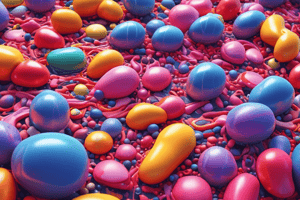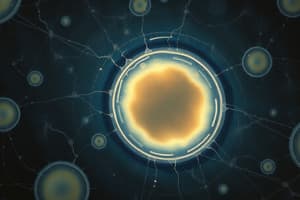Podcast
Questions and Answers
What is the primary function of the plasma membrane?
What is the primary function of the plasma membrane?
- To store genetic information
- To provide energy to the cell
- To facilitate protein synthesis
- To regulate the entry and exit of molecules (correct)
What type of structure is the phospholipid plasma membrane?
What type of structure is the phospholipid plasma membrane?
Bilayer
What is the other name for the plasma membrane?
What is the other name for the plasma membrane?
Fluid mosaic model
What are the two main elements of the phospholipid bilayer?
What are the two main elements of the phospholipid bilayer?
What substance helps to maintain the stability of the plasma membrane?
What substance helps to maintain the stability of the plasma membrane?
What are the proteins that are bound to the hydrophobic interior of the plasma membrane called?
What are the proteins that are bound to the hydrophobic interior of the plasma membrane called?
In what type of solution will a cell lose water and shrivel?
In what type of solution will a cell lose water and shrivel?
In which type of solution will water move into the cell and potentially cause it to burst?
In which type of solution will water move into the cell and potentially cause it to burst?
What process allows a cell to take in large macromolecules?
What process allows a cell to take in large macromolecules?
What is the term for the process where a cell releases macromolecules?
What is the term for the process where a cell releases macromolecules?
What type of solution maintains equal water movement in and out of the cell?
What type of solution maintains equal water movement in and out of the cell?
What type of transport does not require energy?
What type of transport does not require energy?
What type of transport requires energy?
What type of transport requires energy?
What type of diffusion requires a protein for transport?
What type of diffusion requires a protein for transport?
What is the movement of molecules across a membrane called?
What is the movement of molecules across a membrane called?
What is the movement of water molecules across a membrane called?
What is the movement of water molecules across a membrane called?
What is cellular drinking also known as?
What is cellular drinking also known as?
What is cellular eating called?
What is cellular eating called?
What is the movement of material outside of the cell known as?
What is the movement of material outside of the cell known as?
Flashcards are hidden until you start studying
Study Notes
Plasma Membrane Structure and Function
- The plasma membrane surrounds all cells and consists of a double-layer of phospholipids, cholesterol, and proteins.
- Phospholipids have hydrophilic (water-soluble) heads and hydrophobic (water-insoluble) fatty acid tails.
- The phospholipid bilayer's arrangement ensures that heads face the aqueous environment inside and outside the cell, while tails face inward.
Phospholipid Bilayer
- The bilayer creates a hydrophobic interior and a hydrophilic exterior, enabling selective permeability.
- Proteins can be integral (embedded within) or peripheral (attached to one side) of the membrane.
Role of Cholesterol
- Cholesterol acts as a patching substance in the plasma membrane, maintaining fluidity by preventing phospholipid tails from crystallizing.
- It ensures the membrane remains functional in varying aqueous conditions.
Solutions and Water Movement
- In a hypertonic solution, water moves out of the cell, causing it to shrivel.
- In a hypotonic solution, water moves into the cell, potentially leading to cell bursting.
- Isotonic solutions maintain equal water movement in and out of the cell.
Transport Mechanisms
- Passive transport does not require energy; molecules move freely across the membrane.
- Active transport requires energy to move molecules against their concentration gradient.
- Facilitated diffusion requires specific protein channels for the transport of molecules.
Endocytosis and Exocytosis
- Endocytosis allows a cell to intake macromolecules, categorized into:
- Phagocytosis (cellular eating) for larger particles.
- Pinocytosis (cellular drinking) for smaller liquid particles.
- Receptor-mediated endocytosis, which involves specific ligand binding.
- Exocytosis releases macromolecules from the cell, where vesicles fuse with the plasma membrane, spilling contents outside.
Osmosis
- Osmosis specifically refers to the movement of water across a membrane from lower solute concentration to higher concentration, crucial for cellular fluid balance.
Summary of Cell Transport Types
- Passive transport: movement of substances without energy.
- Active transport: movement of substances requiring energy.
- Facilitated diffusion: transport needing proteins.
- Diffusion: general movement of molecules.
- Osmosis: specific movement of water molecules.
Studying That Suits You
Use AI to generate personalized quizzes and flashcards to suit your learning preferences.




